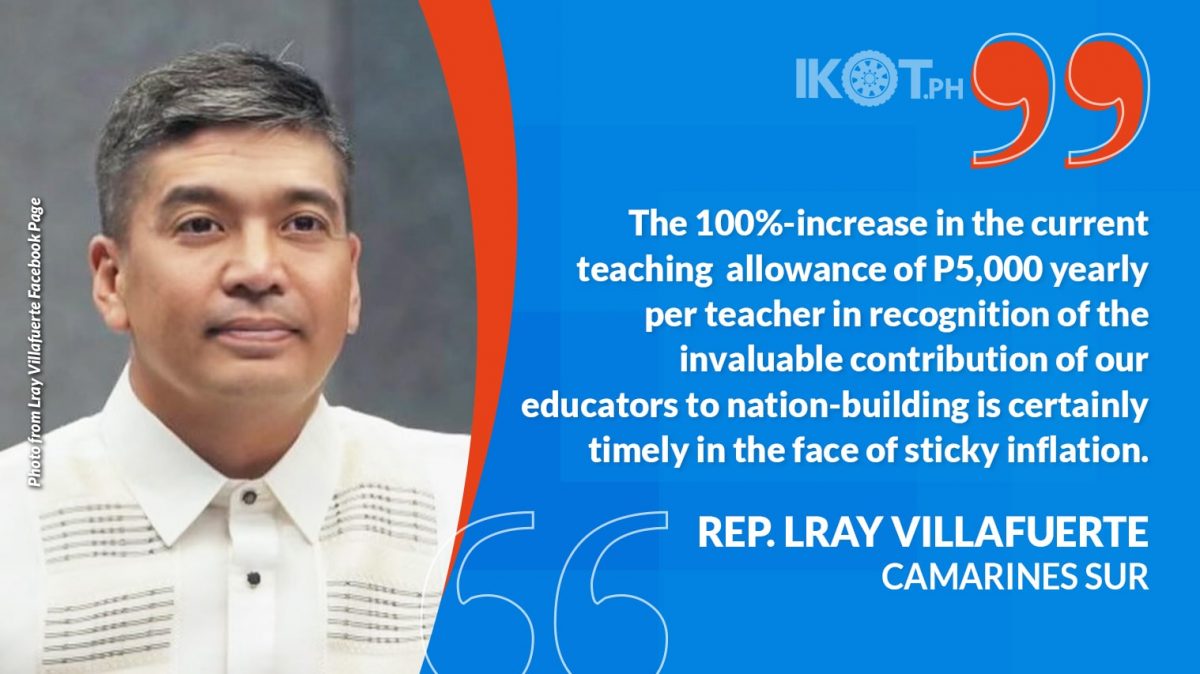A higher annual allowance of P10,000 next schoolyear awaits not only public school teachers with teaching loads in basic education but even vocational instructors, librarians, guidance counselors, and teachers in the Alternative Learning System (ALS) and community learning centers as well, according to National Unity Party (NUP) president LRay Villafuerte.
A co-author of Republic Act (RA) No. 11997, or the “Kabalikat sa Pagtuturo Act,” Villafuerte said this teaching allowance is tax-free and is considered an outright expense, so that the beneficiaries no longer have to submit or present official receipts (ORs) as proof of their purchases.
Villafuerte at the same lauded newly appointed Secretary Juan Edgardo Angara of the Department of Education (DepEd) for the prompt approval of the implementing rules and regulations (IRR) of this law that bumps up the annual allowance of public schoolteachers for their purchases of teaching supplies and materials, payment of incidental expenses, and the implementation of various learning delivery modes in their respective schools.
Angara signed the IRR at the onset of August, or just two months after President Marcos signed RA 11997 last May 31.
Villafuerte is majority leader of the Commission on Appointments (CA), which is the bicameral panel screening presidential appointees that had confirmed swiftly the DepEd posting of Angara, who had at one time or another served as senator, congressman or CA member.
“Despite their heavy workload and essential role as agents of constructive intellectual, social, cultural, political and moral change in our society, our public school teachers are among the most underpaid workers in the country.”
For Villafuerte, “The 100%-increase in the current teaching allowance of P5,000 yearly per teacher in recognition of the invaluable contribution of our educators to nation-building is certainly timely in the face of sticky inflation.”
Villafuerte noted that under the IRR approved by Angara, RA 11997’s beneficiaries are “public school teachers engaged in classroom teaching, whether permanent or provisional, including guidance counselors, school librarians, industrial arts or vocational instructors, and all other persons performing supervisory and/or administrative functions in all public schools.”
Additionally, the IRR states that, “ALS and mobile teachers, and district ALS coordinators, in all public elementary, junior, and senior high schools, and community learning centers are included.”
Teaching load refers to the actual teaching hours or minutes rendered by teachers in the classrooms.
Villafuerte said the IRR excludes from the grant of teaching allowance public school teachers with no teaching loads and performing non-teaching functions, duties, and responsibilities within the current SY; those who are on absence without leave (AWOL), indefinite sick leave, study leave or scholarship within the current SY; and those who are no longer in service as of the official start of the current SY.
However, he said that teachers without teaching loads at the start of the SY but who are eventually assigned teaching loads as well as teachers set to retire in the current SY are entitled to a pro-rated teaching allowance, based on how long they are engaged in classroom teaching.
School heads or head teachers without teaching loads but who end up rendering actual teaching hours because of the absence or unavailability of teachers are also entitled to a pro-rated teaching allowance, he said.
Villafuerte pointed out that as emphasized by Speaker Martin Romualdez following the enactment of RA 11997, the higher allowance was in recognition of the “selfless service of our educators” and to “advance the welfare of public school teachers.”
However, said Villafuerte, “Despite their heavy workload and essential role as agents of constructive intellectual, social, cultural, political and moral change in our society, our public school teachers are among the most underpaid workers in the country.”
Hence, he added, “Providing them with a permanent teaching supplies allowance, and with a provision for a steady bump per SY (schoolyear) will hopefully incentivize them to strive for excellence in their field and make teaching a more attractive profession for young Filipinos.”
The President had signed this law based on the consolidated bill submitted by the 19th Congress before it adjourned sine die last May 25, and that was hammered out from the approved House Bill (HB) No. 9682, or the “Teaching Supplies Allowance Act,” and Senate Bill (SB) No. 1964, or the “Kabalikat sa Pagtuturo Act.”
HB 9682 had consolidated 17 similar measures on teachers’ benefits, including HB 1849 that the NUP president authored with fellow CamSur Reps. Miguel Luis Villafuerte and Tsuyoshi Anthony Horibata.
Villafuerte said the provision of allowance to cover the teachers’ expenses necessary for the delivery of basic education to our students is in keeping with the State policy to “protect and promote the right of all citizens to quality education at all levels and to take appropriate steps to make such education accessible to all.”
Beneficiary-teachers can use the allowance for buying tangible or intangible teaching supplies and materials, paying incidental expenses, and conducting various learning delivery modalities.
But the law’s IRR excludes school physicians, nurses and dentists plus other school employees from the grant of teaching allowances.
Citing Philippine Statistics Authority (PSA) data, Villafuerte said that our headline inflation rose to 4.4% in July 2024 from 3.7% in June, bringing to 3.7% the national average inflation over the January-July period.
The spike in the overall inflation in July 2024 was driven mainly by the higher year-on-year YOY rise in the index of housing, water, electricity, gas and other fuels at 2.3% that month from 0.1% in June, he said in citing PSA figures.
Food inflation went up to 6.7% in July 2024 from 6.5% the previous month, with the increase brought about largely by the YOY increase in rice and other cereal products, meat items, vegetables and ready-made foodstuff.


